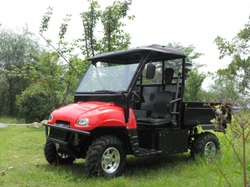|
Cars overheat most often in very hot weather. It’s rare with modern vehicles, but even a well-tuned automobile can overheat. If you find yourself in stop-and-go traffic or climbing a steep grade on an extremely hot day, and your dashboard temperature indicator starts to rise or a malfunction indicator light comes on, here’s how to help your vehicle regain its cool: At the first sign of overheating, shut off your air conditioner and open your windows: Doing so decreases the load on the engine and helps it cool off.
If you continue to overheat, turn on the heater and blower: Doing so transfers the heat from the engine to the passenger compartment of the vehicle. (This does wonders for your overheated engine but very little for you!) If you’re stopped in traffic and the temperature gauge is rising, shift into Neutral or Park and rev the engine a little: Doing so makes the water pump and the fan speed up, which draws more liquid and air through the radiator. The increased air and liquid circulation helps cool things off. Try not to ride your brakes: In stop-and-go traffic, crawl along slowly, on little more than an idle, rather than moving up and then braking repeatedly. Brake drag increases the load on the engine and makes it heat up. If traffic is crawling, move up only when the gap between you and the vehicle in front of you gets too large. If you think that your vehicle is about to boil over, drive to the right-hand side of the road, open the hood, and sit there until things cool off. Remember, don’t open the radiator cap under these circumstances, and if your engine has boiled over, don’t add water until the engine is quite cool again. If you must add water when the engine is still a little warm, add the water slowly while the engine is running in Neutral or Park. Although hot weather is the most common cause of overheating, many other factors can cause the same problem. If your vehicle overheats in traffic in normal weather, one of the following may be the culprit:
If you can’t locate any leaks, your thermostat may be malfunctioning. Obviously, you can’t replace the thermostat at the side of the road. In the meantime, if you can park and get to the thermostat safely, you can eliminate this malfunction as a possibility. Wait until the engine cools down completely, and remove the old thermostat and reconnect the hoses without it. If the engine starts up and runs well without the thermostat, the old one was probably screwing up the works. Get a new thermostat immediately if you find that your old one isn’t working. Driving for long distances without a thermostat can damage your engine.
0 Comments
Leave a Reply. |
Categories
All
Archives
December 2019
|


 RSS Feed
RSS Feed
